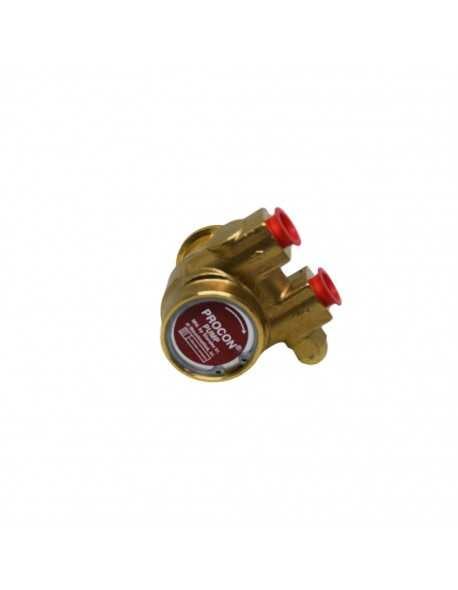




€104.60 tax excl.
 Security policy
Security policy
(edit with the Customer Reassurance module)
 Delivery policy
Delivery policy
(edit with the Customer Reassurance module)
 Return policy
Return policy
(edit with the Customer Reassurance module)
The rotary vane espresso machine pump. There are various brands which manufacture these pumps like Fluid o tech, Nuert and Procon. The pump on this page is made by the company Procon. Part number 132A060F123B
The pump on this page is called a rotary vane clamp pump. The pump is clamped on a flange with a stainless steel clamp. If you tighten this clamp the pump will attach to the motor. Always pay attention to what kind of shaft connection the pump has, this is a standard square shaft which is suitable for most espresso machine motors.
This specific model of pump has a flowrate of 180 L/H and has a balanced bypass. The motor is NSF certified
The fittings used on this pump are a 3/8” NPT instead of the 3/8” BSP-G used by Fluid o tech and Nuert.
On the side of the pump you can find a small adjustment screw where you can adjust the pump pressure, if you want to increase the pressure screw it inwards and reduce the pressure screw it outwards.
On what kind of espresso machine brands can you use this pump? This varies from Astoria, Gaggia,Grimac, Magister, La Pavoni, Rancilio, San Marco, Vibiemme to Wega.
But if you ware not sure send us a picture of your pump and details about the espresso machine and we might be able to help you to find the correct pump for your espresso machine
Data sheet
Well that answer is pretty simple, no it isn’t. The original valve works as following, when you turn the shaft inwards the valve pin will push a gasket holder. The steam can go out, close it again and no steam can go out. In the case of the modern E61 valves is that behind the gasket holder is a small stainless steel ball with a spring.
From the beginning of the Faema E61 brewing group are basically no differences between the parts installed inside the brewing group. Parts such as the valve gaskets, springs, valve assemblies and portafilters have all remained the same. The biggest change is the small cleaning hole on the front of the brewing group. With the earliest models this hole didn´t exist.
There are 5 types of boiler used on the Faema E61 espresso machine. The most well known is the double flanged model. You have on one side the heating element flange and on the other side the water level flange, both are out of production. These are held in place with aluminium boiler rings. For the single groups you have a boiler with a flange on one side.
The next model is a stainless steel boiler, with one flange. This type of boiler is less common then the copper boiler above. There is also a later model stainless steel, which doesn’t have a removable flange. Both these boilers have corrosion issues, this has to do because of the stainless steel.
The latest model is also a copper boiler, this boiler has a single heat exchanger(HX) in the middle. Most modern espresso machines have for each individual brewing group a individual HX.
Yes it is, but this depends on various factors. The first thing is experience, seen this is a manual operated espresso machine it requires a lot more attention from the barista then a solenoid operated model. There you need to stop the brewing process manually. If you don’t have the experience you probably can’t hold up with the tempo which is required at such a bar. Then I would advice to go for the Faema E61 Jubilee, this is the solenoid operated version of the Faema E61 Legend espresso machine.